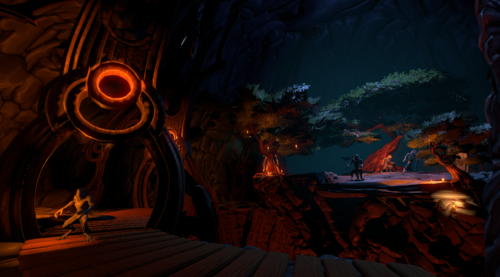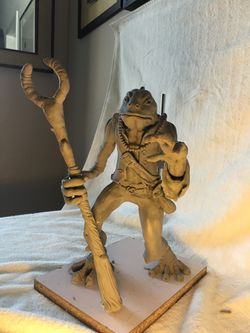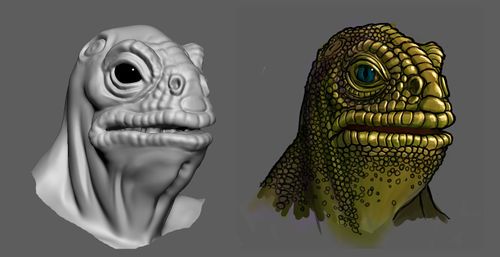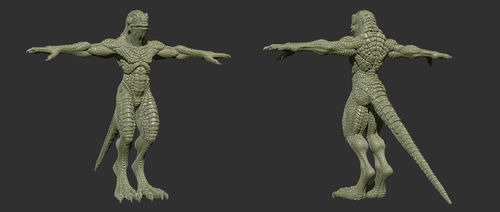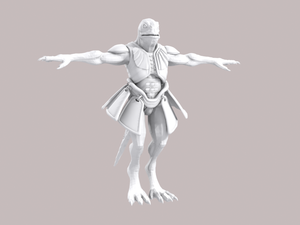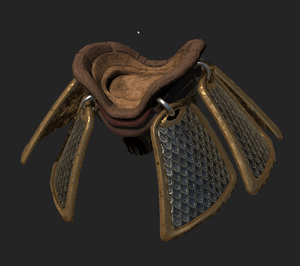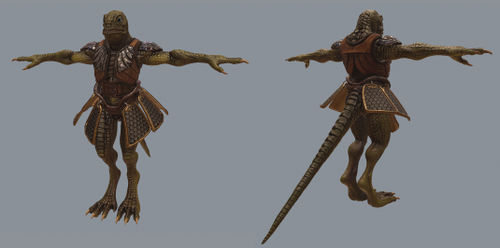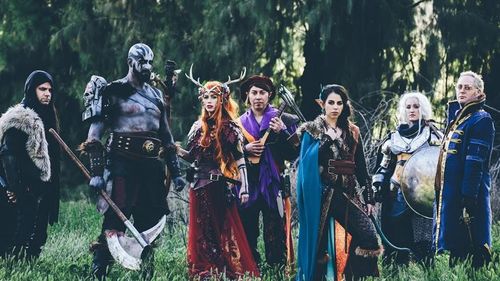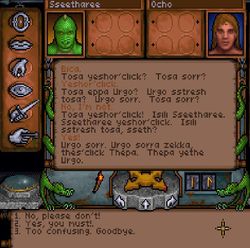Stygian Sentinel 33
It’s been a busy month, despite the best efforts of New England snowstorms to undermine progress.
As you know, we’ve shared several rounds of work-in-progress screens, footage, and prototypes, as part of our promise to give a deep look at the game development process. Recently our focus has been improving both our look and core gameplay of the game.
We’ve also been hard at work honing the Improvisation Engine — the bevy of tools that empower you to come up with your own creative solutions to problems — in an effort to make Underworld Ascendant the next step in player-authored gameplay. That’s involved progress with combat, stealth, magic, in-world interactables, and AI.
There is a LOT that goes under the hood to make it all work. We’re close to having something ready to share, but still need to do some further balance and polish.
To tide you over in the meantime? Here’s an early in-game peek.
- A work-in-progress peek, pre-lighting and polish.
The scene has been undergoing steady revisions and is currently getting a VFX pass, but you’ll get a sense of the direction we’re heading.
We also have new, behind-the-scenes dives into the development process, focused on series’ mainstays the Lizard Men and with exclusive new shots and audio.
Hope you enjoy!
The Evolution of the Lizard Men – Part 1: The Look[edit]
We recently spoke with character artist Jed (BioShock, Rock Band) Wahl about his current modeling work on Underworld Ascendant’s Lizard Men, his early efforts on the BioShock series, and how he got his start.
What originally got you into modeling for games?
I started making digital models at the MIT Media Lab, creating characters for interactive installations designed by graduate students. I got interested in pursuing 3d modeling professionally after participating in some contests held by the late, great Paul Steed at the website Polycount. Paul gave me a lot of encouragement and his book on using 3d Studio Max was a real godsend for me. I really owe that guy a lot.
What was your first game?
My first shipped game was Irrational’s Swat 4, working as an environmental modeler. My favorite part about that project was coming up with the theme and decor of the serial killer’s lair.
Did we hear correctly that you did all the character models for BioShock? Which was your favorite to work on?
I sculpted the high and lowpoly models for most of the characters, including the Splicers, the Bouncer, Little Sister, Andrew Ryan, Atlas, and the player hands.
My fav is definitely the Bouncer, designed by our own art director Nate Wells. As soon as we saw his ortho design, we felt it could become an iconic character.
My first pro character model ever was an early Splicer concept, also by Nate. This was before programs like Zbrush, so he was done using old-school box modeling methods in 3ds Max.
Something I wish we’d had time to put into the game involved rare Little Sisters dressed in outfits raided from an abandoned costume shop. Their expressions would be modded to suit their pretend identity; a cowgirl Sister could have referred to her Big Daddy as “Sheriff,” while a space cadet could call him “Commander,” for example. It would have been a fun way to add variety to the Sisters, but there was simply no time in the schedule to make them.
Can you walk us through the process of modeling the Lizard Man for Underworld Ascendant?
Since this was the first sentient character we’ve designed for the game, there was a lot of iteration and experimentation involved. We also wanted to find a good middle ground between the two major concepts that we’d shown in the backer poll some time ago: a design that was overtly lizard-like while also having the potential to appear intelligent and civilized.
Nate explored concepts via clay and I made a series of quick rough models in Zbrush that explored different proportions and features. A great tool during this process was Adobe’s auto rigging tool Mixamo, which it allowed me to take these simple models and quickly get them moving so I could evaluate how their silhouettes looked in a variety of actions. I’ve included a small sampling of these experiments here, starting with a version inspired by our Blue Lizardman from the poll. From there we explored making him less chameleon and more iguana based, and you can see how he evolves from a more whimsical race to one with a build that can demonstrate equal amounts of strength, agility, and nobility.
- Early modeling explorations by Jed
Once Nate was happy with the overall forms of the lizardman, he did a drawover of the model’s face to define the kind of scale treatment he was looking for.
- Jed’s early model w/ drawover reference by Nate
From there I refined the hipoly model in Zbrush. This is also one of our first characters done in the “authored style,” so there’s a lot of experimentation involved at this stage as well.
- A high poly work-in-progress render of the Lizard Man (sans armor)
I generally approach it stylistically as though I’m making a fantasy miniature (which I’ve sculpted about two hundred of while working for the board game company Greenbrier Games), but still allowing for more detail that I know would end up being lost on a 28mm scale figure.
- Low poly renders of the Lizard Man
I created a low poly model from that using the Freeform tool in 3dsMax. His polycount is about 18k, a far cry from the 4-6 thousand used in Bioshock. He was UV mapped in 3dsMax and his normal maps were projected in Knald. From there, I began texturing in Substance Painter.
Next time, we’ll show the final pass at the Lizard Man, plus give a new peek at the Mind Crippler. Anything you want to tell fans about it?
The Mind Crippler has been great fun. It’s much more bizarre and otherworldly than what I usually get to make. I’ve always loved/been repulsed by brain-themed creatures… One of my favorite toys as a kid was a cheap PVC figure of a Grell from Dungeons & Dragons. Working on this feels like a fun homage to that thing.
Thanks! Right before we published this update, Jed sent over a few additional rounds of texturing and modeling, which we’ll share here.
- Now with (unweighted) armor.
- A close-up look at textures for the lower armor.
- Altogether now!
After final texture feedback from Nate, it’ll be sent over to our animator Dax to weight the armor to hang and more. Next time, you see the Lizard Man, he’ll be animated, armed, and in-game!
For more on Jed’s video game and miniature work, check out his portfolio here.
The Evolution of the Lizard Men – Part 2: The Voice[edit]
For the next stage in bringing the Lizard Man to life, we stepped into the studio with talented voice performer, Liam O’Brien.
One of the reasons why we enjoy collaborating with Liam is the care and depth he brings to every role, whether he’s playing a narcissistic citizen of Rapture in BioShock Infinite: Burial at Sea or the shrieking, chittering Infected seen in The Last of Us. He’s equally at home with both dramatic roles and monsters.
We checked in with Liam to talk about his career and recording for Underworld Ascendant’s Lizard Man.
What was your first voice acting role? What drew you to the field?
The first VO job I ever landed was doing an English dub for a Japanese animated series called Boogiepop Phantom. I was playing a disturbed teenager obsessed with dating sim games. He was the first in a long line of nutters I have had the pleasure of portraying.
When I stumbled into voice over, I was busy cutting my teeth on stage, trying to be a serious actor. But in the background, I was always pretty preoccupied with games and animation. I had a small, growing collection of anime at the time, so the chance to work on that kind of a project was a huge thrill, and luckily started the Rube Goldberg going that lead to the rest of my career.
What are some of your favorite voice acting game roles?
Well, I have been in love with Tolkien’s books my entire life, so getting to do full performance for Gollum in Shadow of Mordor rates pretty high. And neck and neck would be Illidan from The World of Warcraft, which is a role I’ve gotten to live in for somewhere around a decade at this point?
You’re also a gamer yourself. What grabbed you first: pen and paper or interactive?
I still remember when I was five and my father brought home a machine called The Vectrex, which is where gaming started for me. That was followed up with the original Atari. So I hit video games first. It’s funny, though. My father published an early video game magazine for a short time called Electronic Fun, so I had access to a lot of games at an early age. But the magazine shuttered just before the NES arrived on the scene, and I missed out on that massive wave.
It was right around then that I stumbled across the D&D Red box, Dragon Lance, Forgotten Realms, and tabletop gaming in general. That lasted through my high school years, then faded as I got to NYU. I spent my college years being an over eager acting student, but once I started going out on the road to do theatre, I found my way back into gaming through the original PlayStation.
You’ve been a regular since the start on the Geek & Sundry’s Critical Role, where you and a group of other voice performers play D & D live on camera each week. How’d you become involved?
Long story. I got to know our Dungeon Master, Matthew Mercer, working on Resident Evil 6 several years back. I was directing him and we hit it off in the studio, and he began inviting me to sit in on the campaign he was running. I kept passing, due to a lack of free time, but after the game wrapped, I ended up asking him to run a one-shot game for me and a handful of other actor-y friends, and we were all hooked.
- The Critical Role crew in character. (Liam – far left)
We played at home for a few years, and word got out about the voice actor game of D&D. Felicia Day at Geek & Sundry caught wind of us, and we ended up picking up the game and carrying it in front of a camera. We have been playing now for about 5 years, and are basically a family now.
What’s your favorite D & D module? And favorite (console or PC) RPG?
That is such a hard question to answer. Jeez. I mean? Matt’s campaign, probably? I don’t know anyone more creative than Mercer. The longer I work and play with him, the more enraptured I am with his imagination. Kind of amazing that my first real DM is arguably one of the greatest of all time.
I’ve also begun DM-ing again (I did as a teenager), in three separate games for my kids, and I’m pretty taken with Wizards of the Coast’s Curse of Strahd. I didn’t play the original Ravenloft, but I could not stop reading the book they put together for 5th edition.
As far as RPGs go? How about some of my favorites? I loved Pool of Radiance, Wasteland, and Baldur’s Gate back in the day. Phantasy Star on the SEGA Master System. I’ve loved Fallout 3 and every follow up since. And Skyrim swallowed me whole for quite a while. That might have been the last RPG I made time to get lost in for months.
You recently recorded for Underworld Ascendant’s Lizard Man. Any unique challenges speaking in their language?
I definitely tried to channel the feel of a real world language and accent. Cold reading is at the center of most game VO, as you are usually seeing dialogue for the first time when you walk in the booth. So trying to invent a cadence of lilt for something I had no prior knowledge of would probably have been dicey. It helps to have a base to work from.
I think on some level, I always hope that our creature-y, foul mouthed ad libs will get slipped into the game somehow as well, but so far, no dice.
Thanks, Liam!
Here’s an exclusive early preview of Liam’s Lizard Man voice work:
Can you translate these lines from Lizard Man into common tongue? Share on our forums!
Update: Lizard Man Language Fan Participation[edit]
Speaking of… Last month, we mentioned how the Lizard Men — who were part of a particularly well-loved sequence in the original Ultima Underworld — will play a big role in Underworld Ascendant.
We invited fans to help us expand their vocabulary even further and the response so far has been phenomenal.
Many thanks to all who have contributed!
Check out the latest progress right here.
And remember, it’s not too late to help! You may hear your suggestions voiced in-game.
In Other News…[edit]
And finally, a few things you might find interesting:
- SWAT 4 — which our own Nate Wells and Jed Wahl helped develop — is now available on GOG.
- Obsidian’s Pillars of Eternity II: Deadfire is in its final hours of crowdfunding on FIG!
- Stoic’s Banner Saga 3 is wrapping up its last few weeks on Kickstarter.
- ICYMI – Glixel recently ran a selection from Ultima creator Richard Garriott’s upcoming memoir, Explore/Create.
- inXile’s eagerly-anticipated RPG Torment: Tides of Numenera is launching next week! Look for it at midnight PST on the 28th for Windows, Mac, Linux, PlayStation 4, and Xbox One.
Until next time!
Best,
The Team at OtherSide

